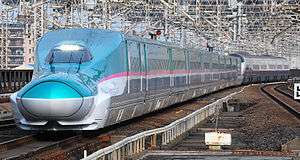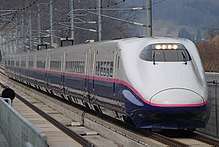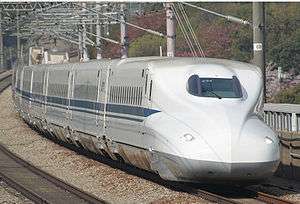Hayate (train)
Hayate (はやて) is a high-speed Shinkansen service operated in Japan, on the Tohoku Shinkansen by East Japan Railway Company (JR East) since 2002 and on the Hokkaido Shinkansen by JR Hokkaido since 26 March 2016. It operates as far as the northern terminus of Shin-Hakodate-Hokuto, and it is the second-fastest service on the Tohoku Shinkansen, operating at a top speed of 275 km/h (170 mph) between Utsunomiya and Morioka. These services were inaugurated with the opening of the Tohoku Shinkansen extension to Hachinohe on 1 December 2002.[1]
 E5 series set U6 on a Hayate service in November 2011 | |
| Overview | |
|---|---|
| Service type | Shinkansen |
| Status | Operational |
| Locale | Honshu/Hokkaido, Japan |
| First service | 1 December 2002 |
| Last service | 16 March 2019 (Hayate 119) |
| Successor | Hayabusa |
| Current operator(s) | JR East/JR Hokkaido |
| Route | |
| Start | Morioka |
| End | Shin-Hakodate-Hokuto |
| Distance travelled | 823.8 km (511.9 mi) |
| Service frequency | Hourly |
| Line(s) used | Tohoku Shinkansen, Hokkaido Shinkansen |
| On-board services | |
| Class(es) | Standard + Green + Gran Class |
| Catering facilities | Trolley service |
| Technical | |
| Rolling stock | E5 series, H5 series |
| Track gauge | 1,435 mm (4 ft 8 1⁄2 in) |
| Electrification | 25 kV AC overhead |
| Operating speed | 275 km/h (170 mph) |
The name "Hayate" has not been used previously on any train service in Japan. The name was chosen with input from the public; roughly translated, it means a strong or violent wind; however, it carries positive connotations of speed and power.
History
Introduction
In December 2002, the Tohoku Shinkansen extended to Hachinohe. As a result, the Hayate was introduced, in order to serve the newly extended section between Morioka and Hachinohe. Hayate trains ran between Tokyo and Hachinohe, and skips all stations between Ōmiya and Sendai. The Hayate was established as the fastest service on the Tohoku Shinkansen at that time, which also established its position as the predecessor of the Hayabusa. All seats in Hayate trains require reservation, due to the popularity of Shinkansen services from Tokyo to the Tohoku region. Hayate trains were operated by 10-car E2 series units, which ran at a top speed of 275 km/h.
Shin-Aomori Extension
On 4 December 2010, the Tohoku Shinkansen extended again to Shin-Aomori. And in 19 November 2011, E5 series trainsets, with maximum speeds of 320 km/h, were introduced to the line, with some of them used on Hayate services.[2] The introduction of the E5 series resulted in the introduction of the Hayabusa, which replaced the Hayate's role as the fastest train on the line. In addition, currently E5 series Hayate services still run at a top speed of 275 km/h. JR East have reduced Hayate services over the years, and unify the discontinued Hayate services to Hayabusa services. It now serves as a complementary service to the Hayabusa.
Opening of Hokkaido Shinkansen
From 26 March 2016, with the opening of the Hokkaido Shinkansen from Shin-Aomori to Shin-Hakodate-Hokuto, the Hayate name is also used for services operating between Morioka, Shin-Aomori, and Shin-Hakodate-Hokuto.[3] As of March 2016, one return service operates daily between Morioka and Shin-Hakodate-Hokuto, and one return service daily operates between Shin-Aomori and Shin-Hakodate-Hokuto. These services are formed of 10-car E5 or H5 series trainsets.[4]
Future plans
Past services with Komachi
In the past Hayate services used to couple with Komachi services from Tokyo to Morioka, where the Komachi cars are uncoupled and proceed to Akita Station via the Akita Shinkansen. However currently all Komachi train now couple with Hayabusa trains, so all Hayate trains now run alone.
Stations and service pattern
Hayate services stop at the following stations.
| Station | Train Number | |||
|---|---|---|---|---|
| English | Japanese | Hayate 93, 98 | Hayate 91, 100 | |
| Morioka | 盛岡 | ● | ||
| Iwate-Numakunai | 盛岡 | ● | ||
| Ninohe | 二戸 | ● | ||
| Hachinohe | 八戸 | ● | ||
| Shichinohe-Towada | 七戸十和田 | ● | ||
| Shin-Aomori | 新青森 | ● | ● | |
| Okutsugaru-Imabetsu | 奥津軽いまべつ | ● | ● | |
| Kikonai | 木古内 | ● | ● | |
| Shin-Hakodate-Hokuto | 新函館北斗 | ● | ● | |
Travel time
- Morioka - Shin-Hakodate-Hokuto: 2 hours 9 minutes
- Shin-Aomori - Shin-Hakodate-Hokuto: 1 hour 6 minutes
Rolling stock
- E5 series (since November 2011)
- H5 series (since 26 March 2016)[4]
- E5 series
- H5 series
Train formations

Hayate services are operated by 10-car JR East E5 series or JR Hokkaido H5 series train sets, with car 1 at the Morioka end. All seats are reserved and no-smoking.[4]
E5 & H5 series Hayate
| Car No. | 1 | 2 | 3 | 4 | 5 | 6 | 7 | 8 | 9 | 10 |
|---|---|---|---|---|---|---|---|---|---|---|
| Class | Standard | Standard | Standard | Standard | Standard | Standard | Standard | Standard | Green | Gran Class |
| Facilities | Cardphone | Cardphone/ Wheelchair space | Wheelchair space |
References
- JR新幹線&特急列車ファイル [JR Shinkansen & Limited Express Train File]. Japan: Kōtsū Shimbun. 2008. p. 16. ISBN 978-4-330-00608-6.
- 東北新幹線「はやぶさ」に投入しているE5系車両を「はやて」「やまびこ」に導入! [Tohoku Shinkansen "Hayabusa" E5 series trains to be introduced on "Hayate" and "Yamabiko" services] (PDF). Press release (in Japanese). Japan: East Japan Railway Company. 12 September 2011. Retrieved 12 September 2011.
- 北海道新幹線の列車名決定について [Details of Hokkaido Shinkansen train names] (PDF). News release (in Japanese). Japan: Hokkaido Railway Company. 20 November 2014. Retrieved 20 November 2014.
- JR時刻表 [JR Timetable] (in Japanese). Japan: Kotsu Shimbunsha. 2016. p. 977. EAN 4910053110464.
External links
- JR East E2 series Hayate (in Japanese)
- JR East E5 series Hayabusa/Hayate/Yamabiko/Nasuno (in Japanese)


.svg.png)